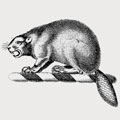Cleopatra's Needle (London) - Silver Urn Presented to General Sir James Alexander, 1878
£15,000.00
YEAR OF MANUFACTURE: 1878
ORIGIN: London, England
MAKER: R. HODD & SON 30 & 31 HATTON GARDEN LONDON E.C.
Featured Crests

Item Description

Measurements: Height: 46cm (18in)
Silver and silver-gilt. Modelled in the Neo-Grec style and of twin handled ovoid form with tapering neck and outswept cupped rim, on circular pedestal base, the whole finely chased with lotus, anthemion, vitruvian scroll and Greek key banded decoration. The body further engraved with the arms, orders and decorations of General Alexander on one side and on the other the presentation inscription: ‘By friends and neighbours / PRESENTED TO / Lieut. General Sir James Edward Alexander / C.B - K.C.L.S - F.R.S.E / IN APPRECIATION OF HIS ZEALOUS & SUCCESSFUL EFFORTS / TOWARDS REMOVING THE CLEOPATRA OBELISK FROM / ALEXANDRIA TO THIS COUNTRY AND IN TOKEN OF / RESPECT FOR HIS PRIVATE CHARACTER./ MAY 1878.’ Hallmarked London 1871 and with maker’s mark of R.H., and further at the foot signed ‘R. HODD & SON 30 & 31 HATTON GARDEN LONDON E.C.’. Cased.
Provenance: Major-General Sir James Edward Alexander of Westerton K.St.J., C.B., F.R.S.E., F.R.G.S., (1803-1885) and thence by descent.
Lieutenant-General Sir James Edward Alexander (1803-1885) was by turns a soldier, linguist, explorer and spy. In 1877 he took up the challenge of transporting Cleopatra's Needle from Egypt to its current home on London’s Victoria Embankment. The needle was presented to Britain in 1819 by the ruler of Egypt in commemoration of Nelson’s victory at Battle of the Nile in 1798 and General Abercromby’s at the Battle of Alexandria in 1801. Although the British Government originally welcomed the gesture, it consistently declined to tackle the
logistical problems and cost of transporting it to London.
The obelisk remained in Alexandria until 1877 when the threat of it being broken up for building material stirred Alexander into action. Alexander won support of the Foreign Secretary, Lord Derby, whose involvement resulted in a meeting with the Khedive of Egypt who duly gave his permission for the removal of the monolith. It was dug out of the sand in which it had been buried for nearly 2,000 years and was encased in a specially designed iron cylinder. The cylinder had ship-like features that included a stern, a rudder, two bilge keels, a mast for balancing sails, and a deck house. Dubbed Cleopatra, it was commanded by Captain Carter and was towed to London by the ship Olga under Captain Booth.
The effort almost met with disaster during a storm in the Bay of Biscay when the Cleopatra began rolling wildly and became uncontrollable. The Olga sent out a rescue boat with six volunteers but the boat capsized and all six crew were lost. Captain Booth eventually managed to get the Olga alongside the Cleopatra and rescued Captain Carter and his crew of five. Booth reported the Cleopatra ‘abandoned and sinking’ but the vessel stayed afloat, drifting in the Bay, until found four days later by Spanish trawlermen, whence it was recovered by the Glasgow steamer Fitzmaurice and taken to Ferrol in Spain for repairs. The Master of the Fitzmaurice lodged a salvage claim of £5,000 which had to be settled before departure from Ferrol, but it was negotiated down and settled for £2,000. The paddle tug Anglia was then commissioned to tow the Cleopatra back to the Thames.
The Cleopatra Obelisk was finally installed on the Victoria Embankment in 1878. A time capsule was concealed in the front part of the pedestal containing: a set of twelve photographs of the best-looking English women of the day, a box of hairpins, a box of cigars, several tobacco pipes, a set of imperial weights, a baby's bottle, some children's toys, a shilling razor, a hydraulic jack and some samples of the cable used in the erection, a 3 inch bronze model of the monument, a complete set of contemporary British coins, a rupee, a portrait of Queen Victoria, a written history of the transport of the monument, plans on vellum, a translation of the inscriptions, copies of the Bible in several languages, a copy of John 3:16 in 215 languages, a copy of Whitaker’s Almanack, a Bradshaw Railway Guide, a map of London and copies of ten daily newspapers.

OFFERED BY:
The Armoury St James's
17 Piccadilly Arcade, London, SW1Y 6NH, United Kingdom View map
 Show this exhibitor's phone number
Show this exhibitor's phone number
 View all of this exhibitor's items
View all of this exhibitor's items
£15,000.00